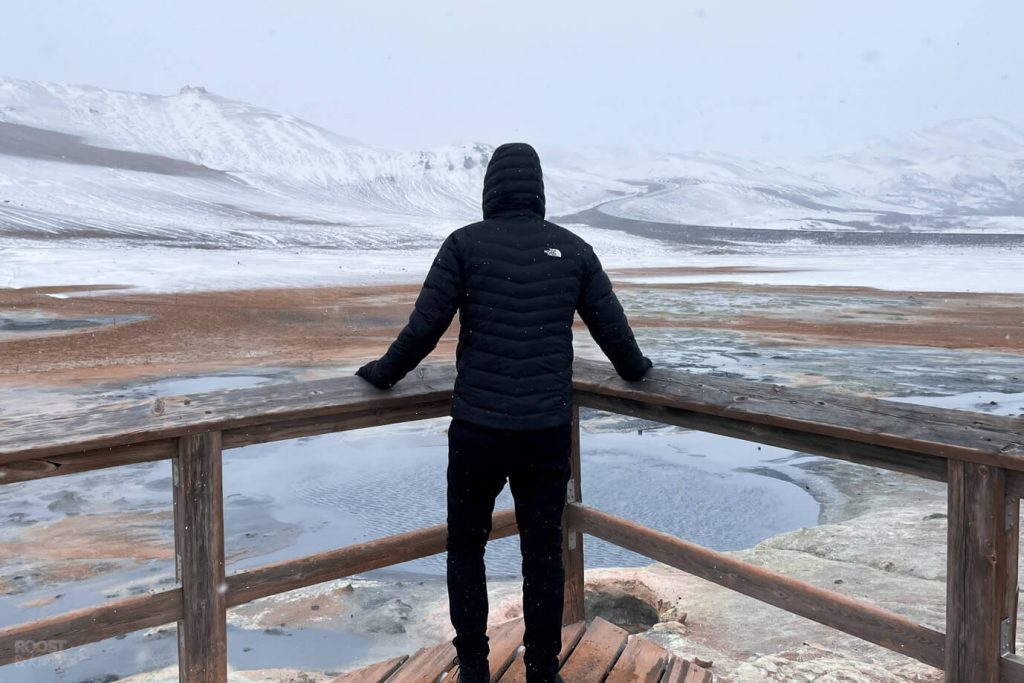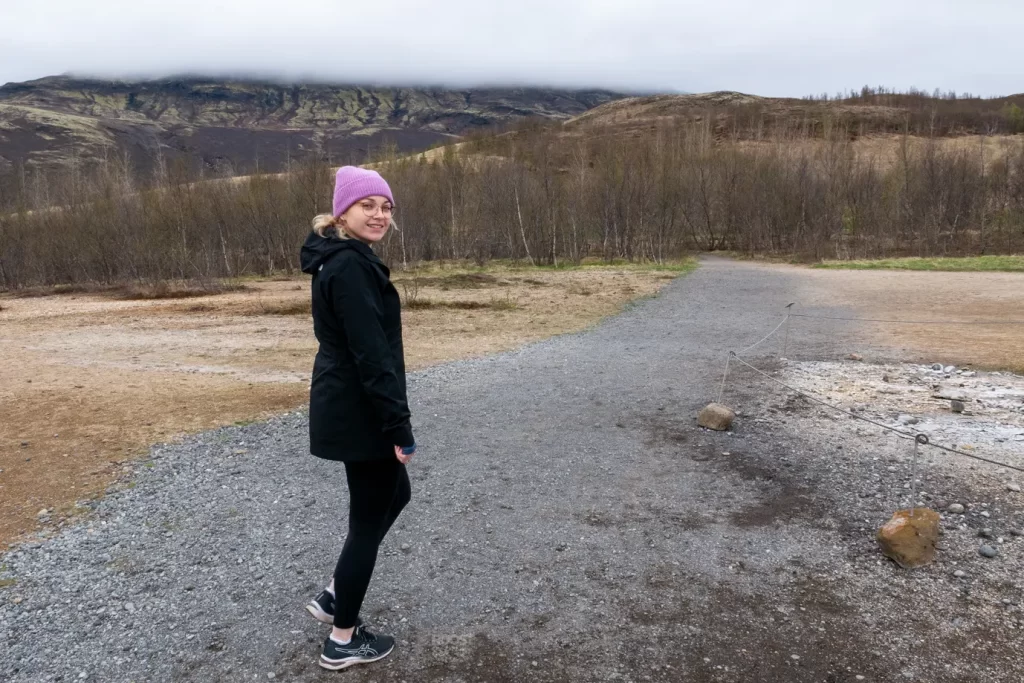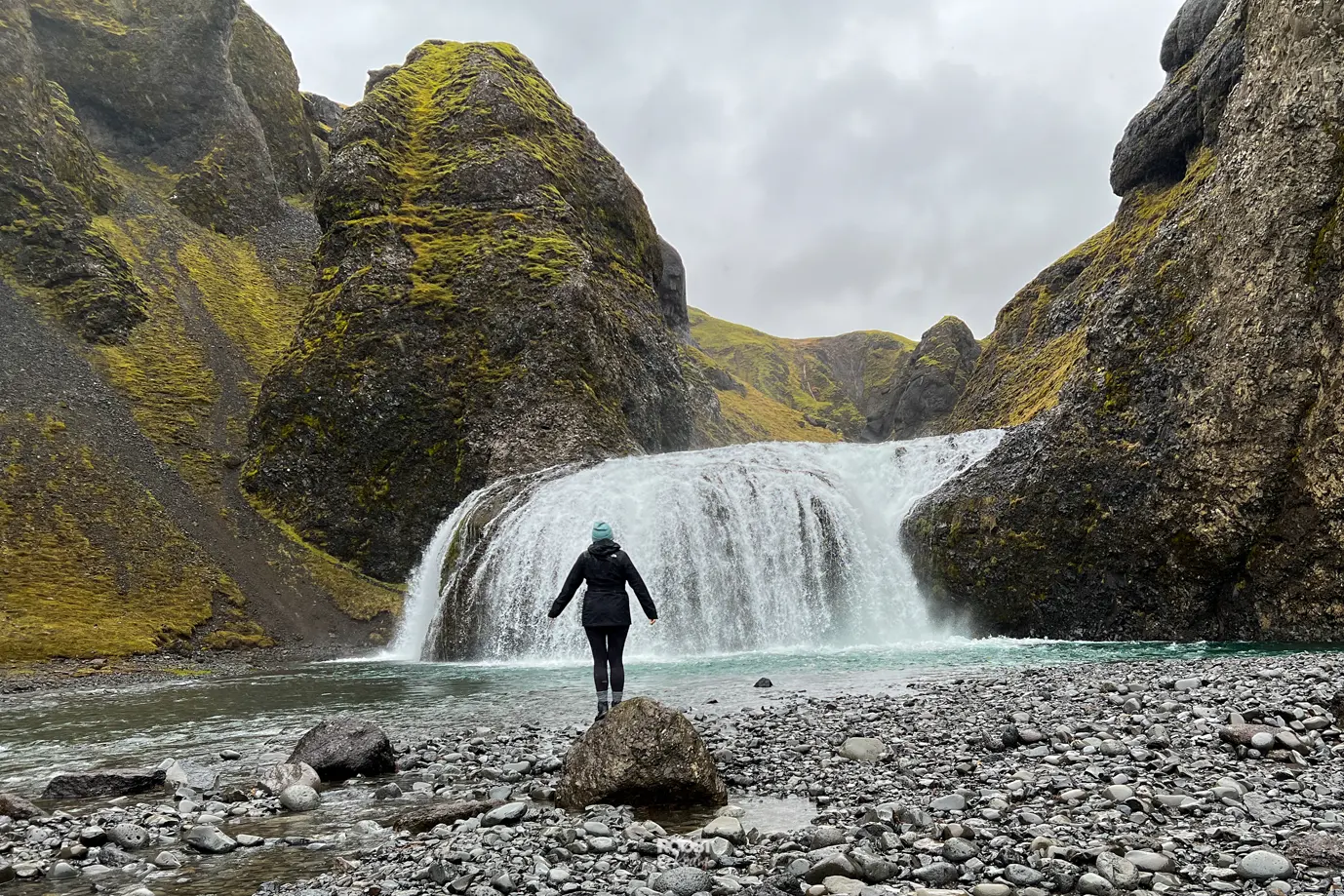Not many holiday destinations require a bikini and a warm insulated coat on the same packing list, do they. But this is Iceland – the land of fire and ice! So you’ll need to pack both in your suitcase if you want to explore this unique landscape to the max.
The notoriously changeable weather can make knowing what to pack for Iceland somewhat of a challenge. You’ll likely experience all seasons throughout one day, changing from glorious sunshine to torrential rain at the blink of an eye. A popular saying amongst Icelanders is: “If you don’t like the weather in Iceland, just wait 5 minutes.” Which couldn’t be any more apt, as the weather in Iceland certainly isn’t afraid to flex its muscles.
Not too dissimilar to our Lapland packing list, you’re going to need plenty of layers to keep you warm in Iceland no matter the season. Even planning a trip around the ‘Midnight Sun’ in the height of summer doesn’t mean hot sunshine in Iceland. You’ll have 24 hours of daylight, but the weather can still be all over the shop with average temperatures not much higher than 50°F/10°C.
So let’s get organised for your upcoming trip, and take a look at everything you’ll need on my ultimate Iceland packing list!

In this article...
What outer layers should I pack for Iceland?
Even in May, Iceland can still be pretty cold. The wind was so intense when we visited, that it made the temperature feel 10x colder than it actually was. Your outer layers are all about protecting you from the elements, so here’s some clothing items you should 100% be packing in spring, summer, autumn and winter.
Windproof coat – The wind in Iceland is no joke, it can rip car doors straight off their hinges! For that reason, I highly recommend a good windproof jacket to stop the cold air tearing through your clothes. Stopping the wind getting through your clothes plays a huge part in keeping you warm in Iceland.
Waterproof coat – If you’re planning on exploring Iceland to the fullest, then you’re going to need a good waterproof coat. Not only will you need a waterproof coat to protect you from the rain, but also from the waterfalls. If you’re planning on seeing the copious amount of waterfalls that Iceland has at its fingertips, then you’re going to need some protection! We came back out from Gljufrabui looking like we had just taken a fully clothed shower.

Down jacket – If your waterproof/windproof coat doesn’t have any insulation and you really feel the cold. Then you may want to consider packing a warm down jacket too. We both packed our North Face down jackets as they take up hardly any space in your suitcase and we could squeeze them under our waterproof coats if we needed an extra layer of warmth.
Gilet – A gilet can be a nice option when a coat is a little too warm.
Walking trousers – You’ll probably be doing a lot of walking in Iceland, so I recommend taking a comfortable pair or walking trousers. This is also something that I wish I invested in. I just wore leggings every day, but it would have been great to have the wind protection from a pair of walking trousers.
Waterproof trousers – This is something that we SO wish we had packed. We didn’t realise just how wet we would get when exploring all the waterfalls along Iceland’s scenic south coast. It would have saved a full outfit change in the back of the car, which required a towel and even dry underwear! Do yourself a favour and pack yourself some waterproof trousers people!
Hat – My ears do not appreciate cold wind blowing around them, and without protection I’m basically asking for an ear ache. Make sure you keep those ears under wraps with a nice warm bobble hat or beanie. We took a couple hats each, so we always had a dry one to wear.
Gloves – Your fingers are one of the first places to get cold, so you’re certainly going to want some gloves. We used a mixture of woollen gloves and our insulated gloves. Any gloves will be better than none. They make a huge difference in your comfort when you’re out battling mother nature. I used these Jack Wolfskin gloves.
Snood – A snood or a scarf is ideal for stopping cold air sneaking down your neck. We used these more in East & North Iceland when we encountered colder temperatures and snow. They were also fab for covering over our noses when we visited Hverir Myvatn to help with the overpowering smell of sulphur.

What mid layers do you need to wear in Iceland, in May?
Your mid layers are all about providing cosy, snuggly warmth. As the weather here changes at the drop of a hat, it’s a good idea to wear multiple thin layers and essentially impersonate an onion. That way, it’s easy to add or peel off layers as and when the weather takes a turn.
Fleece – You can’t beat a fleece when it comes to warmth without the added bulk. Personally I prefer a fleece over a jumper as it means you don’t need to size up on your coat to allow for movement. I use this one from Columbia.
Thermals – To stop the shivers, I wore my thermal top most days which worked a treat at keeping me toasty. Luckily we already had these from our trip to Lapland last December. Just be prepared to get static shocks, polyester seems to charge you up good and proper.
Leggings – I wore leggings everyday, as they were comfortable for both driving, walking and site seeing. You need something that’s going to be good for all of that. Another good option would be jogging bottoms, or James opted for chinos. If you can get your hands on some fleece lined leggings, they will keep you even warmer.
Jeans – I’d swerve wearing jeans out in the rain as you will most likely be cold to the bone and they will take forever to dry off. But you might want to pack a pair of jeans for shopping in Reykjavik or perhaps in the evenings when you head out to dinner.
Socks – To keep your feet warm pack some thermal/thick walking socks.
Top tip: We didn’t pack any smarter clothes for going out. Iceland is very low-key, and people would eat at the restaurants wearing their hiking attire or Icelandic woolly jumpers and jeans.

What foot wear do you need to take to Iceland in spring?
Iceland isn’t the place to pack your impractical stilettos, even in Reykjavik I didn’t see anyone clip-clopping about in high heels. Instead, you really need sturdy, waterproof footwear to explore the best of this country.
Hiking shoes – We all know how much I love my Adidas hiking shoes. They are waterproof, comfortable and offer incredible traction and grip thanks to their continental rubber soles. Make sure you pack something sturdy and waterproof to keep you safe on rough terrain. It also has the potential to be snow covered even in May.
Trainers – Trainers can come in handy when you’re spending time in Reykjavik, or Akureyri. You don’t need your full hiking shoes so much then, and it may be a nice option to be able to wear your trainers on these occasions. We wore trainers on the plane and packed our hiking boots in our suitcase. I actually ended up wearing my Asics trainers all around the golden circle on our first day. Although super comfy, my feet were getting a little chilly!
Flip flops – You certainly wouldn’t want to walk around in flip flops, as your toes would most probably freeze off. But they can be a handy option to have when you’re hopping in and out of the geothermal pools.

All other items you should pack for your Iceland trip
Now we’ve covered all the clothing items that are required. Here’s a list of all the other important things that should be packed into your suitcase.
Hot hands – We packed some hot hands as we had some left over from Finland, but to be honest we didn’t end up needing them. It wouldn’t be a bad thing to keep a pair on you though, especially if you were heading out on a long walk that day. Crack them open and pop them inside your gloves for instant comforting warmth that lasts hours!
Swimming costume – Iceland is full of toasty geothermal lagoons, which you’re going to want to experience. Pack your swimming costume and enjoy finding natural hot-pools in the wild, or visiting the likes of Blue Lagoon and the new Forest Lagoon. I’d suggest packing a couple cossies, so that you always have a dry one to hand.
Quick dry towel – With so many natural hot springs all across the country, you’re going to want to pack a quick drying towel. We took our dock and bay towels which are ideal for this sort of thing.

Sunglasses – Even though there may still be snow about, you might also be blessed with glorious sunshine. It’s best to be prepared for all weathers and pack a pair of sunnies. Especially if you’re going to be driving.
Poncho – We got some plastic ponchos as a Christmas present, and they were great as an additional barrier when the heavens opened.
Rucksack – Having a rucksack can be really handy when you’re off exploring for the day. We used my North Face Jester bag, which held our hats, gloves, snacks, drinks, power bank and ponchos.
Drinking bottle/cup – The tap water in Iceland comes straight from the glaciers and is safe to drink, so save yourself money buying bottled water and fill up a reusable bottle instead. We also took our chilly’s travel cups, and made a cup of tea at the hotel ready to take out on our road trip every morning.
Medicine – Be sure to pack basic medication along with any of the regular stuff you need. In Iceland you cant easily pick up paracetamol or ibuprofen like you can in England. So make sure you bring some with you, or pick some up at your airport before you head over to Iceland.
Eye mask – With 19 hours of daylight at the start of May, and 20 hours come the end of the month. You may want to pack an eye mask to help you drift off, especially if your accommodation isn’t equipped with blackout blinds. To be honest, it never got fully dark when we were there. We packed these silky soft eye-masks from Amazon.
Lip balm – The cold and windy whether can cause havoc with your lips. Combat sore, chapped lips by applying a moisturising lip balm.

Tech and photography packing list
You can’t visit Iceland without snapping some epic holiday photos, and you’re probably going to need a little bit of tech too. Here’s a list of tech and photography items that you might wish to pop into your suitcase.
Power bank – You’re undoubtably going to be taking a lot of photos on this trip. It’s a good idea to keep a battery power bank with you so that you can easily recharge your phone when you’re off exploring. We love the anker ones.
Camera – Because Iceland is full of natural beautiful and you need to capture it! We took our mirrorless camera, but we also took plenty of photos on our iPhones.
Action camera – If you want to get some action shots then I recommend packing an action camera. We took the insta360 and have managed to get some ace footage walking behind waterfalls, and whilst driving along.
Tripod – If you’re serious about getting some incredible photos, star trails or time lapses. Then you may want to pack a tripod to avoid any hand shaking.
Drone – Iceland is a drone lovers paradise. We took ours, but a lot of places don’t allow you fly drones anymore. The windy weather scuppered our plans in the spots we would have been allowed to fly. Rules change all the time, so be sure to check online if you need a licence to fly.
Adaptor – Because you need to be able to charge everything back up again. We use this clever one, which you can adjust to work in most countries. It also saves having lots of different plug adaptors floating about at home.
Waterproof phone case – I took my phone into Blue Lagoon and Forest Lagoon, but had to be careful not to get it wet. A waterproof phone case would have been super handy.

Documents & money you need to bring
I think these go without saying, but make sure you pack the following.
Passport – Obviously!
Drivers licence – If you’re hiring a car, you will need to show your drivers licence.
Money – Icelandic currency isn’t the easiest to get your hands on. We ended up exchanging £100 at the airport (with a daylight robbery exchange rate) but to be honest we didn’t need any cash. I thought we might have needed a small amount during our trip, but we really didn’t. Iceland is well ahead when it comes to cashless payments, with card machines or online payments for pretty much everything! Inform your bank that you’ll be using your bank card/credit card in Iceland, otherwise they may automatically block it for unusual activity. We used our Starling bank account which worked perfectly. Although it never worked at petrol stations, so we had to use our credit card at the pumps.
Map – Before we left England, I bought a map of Iceland to highlight our route. I also marked the sites we wanted to stop at and our hotels. This was so handy when we were on the road just in case we lost signal on google maps. It was also really nice to see how far we had travelled, and where on the island we’d made it to. We used this Marco Polo map.
Travel insurance – Travel insurance is usually pretty cheap, and you should never travel without it. It means you’re covered if you need any medical attention during your holiday, or if you need to claim for any lost luggage. Check your policy covers winter activities if you’re planning on some adventures, as this type of cover is usually additional.

That’s it, time to get packing your suitcase! Have the most incredible time in Iceland, it’s such a unique country.
Check out my other Iceland posts:
- Is Reykjavik Worth Visiting, Things to Consider
- Forest Lagoon – Icelands New Geothermal Spa
- 26 Things to Know Before Visiting The Blue Lagoon
- Iceland Ring Road Trip: 7 Day Itinerary on Route 1
- Exploring Reykjavik: 18 Things to do & Best Places to Visit
